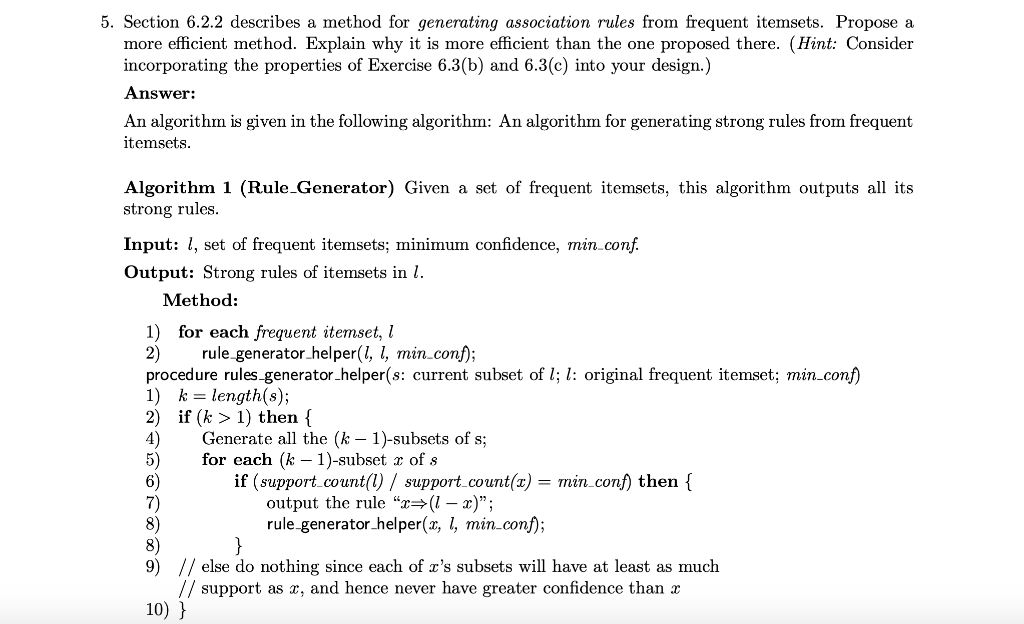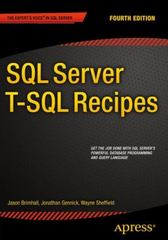I have attached the question and answer for the following question. Can someone please explain the answer in detail. I do not get this at all


5. Section 6.2.2 describes a method for generating association rules from frequent itemsets. Propose a more efficient method. Explain why it is more efficient than the one proposed there. (Hint: Consider incorporating the properties of Exercise 6.3(b) and 6.3(c) into your design.) Answer: An algorithm is given in the following algorithm: An algorithm for generating strong rules from frequent itemsets. Algorithm 1 (Rule Generator) Given a set of frequent itemsets, this algorithm outputs all its strong rules. Input: 1, set of frequent itemsets; minimum confidence, min conf. Output: Strong rules of itemsets in l. Method: 1) for each frequent itemset, 2) rule generator_helper(1, 1, min conf); procedure rules generator_helper(s: current subset of l; 1: original frequent itemset; min-conf) 1) k= length(s); 2) if (k > 1) then { Generate all the (k 1)-subsets of s; 5) for each (k 1)-subset 3 of s if support count(1) / support_count(*) = min.conf) then { output the rule " (1-2)"; rule-generator_helper(x, l, min-conf); 9) // else do nothing since each of x's subsets will have at least as much // support as x, and hence never have greater confidence than x 10) } 6.5 Section 6.2.2 describes a method for generating association rules from frequent itemsets. Propose a more efficient method. Explain why it is more efficient than the one proposed there. (Hint: Consider incorporating the properties of Exercises 6.3(b), (c) into your design.) (b) Prove that the support of any nonempty subset s' of itemset s must be at least as great as the support of s. (c) Given frequent itemset l and subset s of l, prove that the confidence of the rule s' = (1 s') cannot be more than the confidence ofs= (1 s), where s' is a subset of s. 5. Section 6.2.2 describes a method for generating association rules from frequent itemsets. Propose a more efficient method. Explain why it is more efficient than the one proposed there. (Hint: Consider incorporating the properties of Exercise 6.3(b) and 6.3(c) into your design.) Answer: An algorithm is given in the following algorithm: An algorithm for generating strong rules from frequent itemsets. Algorithm 1 (Rule Generator) Given a set of frequent itemsets, this algorithm outputs all its strong rules. Input: 1, set of frequent itemsets; minimum confidence, min conf. Output: Strong rules of itemsets in l. Method: 1) for each frequent itemset, 2) rule generator_helper(1, 1, min conf); procedure rules generator_helper(s: current subset of l; 1: original frequent itemset; min-conf) 1) k= length(s); 2) if (k > 1) then { Generate all the (k 1)-subsets of s; 5) for each (k 1)-subset 3 of s if support count(1) / support_count(*) = min.conf) then { output the rule " (1-2)"; rule-generator_helper(x, l, min-conf); 9) // else do nothing since each of x's subsets will have at least as much // support as x, and hence never have greater confidence than x 10) } 6.5 Section 6.2.2 describes a method for generating association rules from frequent itemsets. Propose a more efficient method. Explain why it is more efficient than the one proposed there. (Hint: Consider incorporating the properties of Exercises 6.3(b), (c) into your design.) (b) Prove that the support of any nonempty subset s' of itemset s must be at least as great as the support of s. (c) Given frequent itemset l and subset s of l, prove that the confidence of the rule s' = (1 s') cannot be more than the confidence ofs= (1 s), where s' is a subset of s








